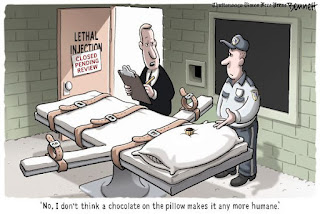“Yong
Vui Kong is young. But if we say ‘We let you go’, what is the signal we are
sending?”
Mr. K.
Shanmugam, Minister of Law and Minister of Foreign Affairs of Singapore has
posed this question. As related in an earlier posting on this blog, Yong Vui
Kong was arrested when 19 years old. He has been condemned to death on a drug
charge. He is now 23 years old.
Here is
an answer to Mr. K. Shanmugam:
The signal
will say, strongly and clearly, human life is inviolable. The Government
respects and acts in respect of this principle. It rejects the trade of drugs
on the same principle, but recognises that killing is not an appropriate
rejection of killing. It is as simple as that.
The message
you send is that this young man has wagered human life for personal gain. He
must be punished. But the punishment will involve rehabilitation, the chance to
remake his life, based on the same conviction that human life must never be
violated.
Meanwhile,
you will admit that capital punishment is not a remedy for the problem of
drugs. Drugs are like cancer. It is an ill of multiple facets. Cancer may be
limited and perhaps cured by therapies which are almost lethal. But cancer must
also be treated by enhancing the life and health of the patient; only the
mentally and bodily strong survive. The incidence of cancer in the community
must be tackled by ensuring a pure environment, eliminating noxious chemicals
and pollutants. Likewise, drugs are a social ill. They multiply in a society
filled with stress and disappointment.
There are
brave new initiatives against the culture of drugs. The basis is an honest
appraisal of the harm of drugs. Amphetamines are not as addictive and
destructive as heroin and its derivatives. The injury of drugs cannot be
measured by mere quantity, such that the death penalty applies to all on a
quantitative scale. Some drugs can be tolerated to the same extent as alcohol
or nicotine. Though their use is regrettable they cannot be measured on the
scale of a human life.
Let Singapore look
to its competitive, stressful, and very unequal society where the invitation to
escape into a drug nirvana becomes attractive. Every life is valuable, life can
be fulfilled in various ways, economic success is not the measure of a life.
The final
message is an admission that the death penalty is not an effective counter to
drug trafficking. Surely, Singapore’s
history as the world’s highest executioner in proportion to its population has
proved this point. Drugs are still traded, and the low level drug dealers are
still executed. For what end? To promote the false premise that Singapore is
serious about drugs? The experience of the great majority of nations rejects
the claim. Let Singapore
respond that its barbarity is ill placed. Your respect for human life will be
warmly welcomed and you will receive encouragement and cooperation in joining
efforts throughout the world to control the morbid trade of drugs and
addiction.


